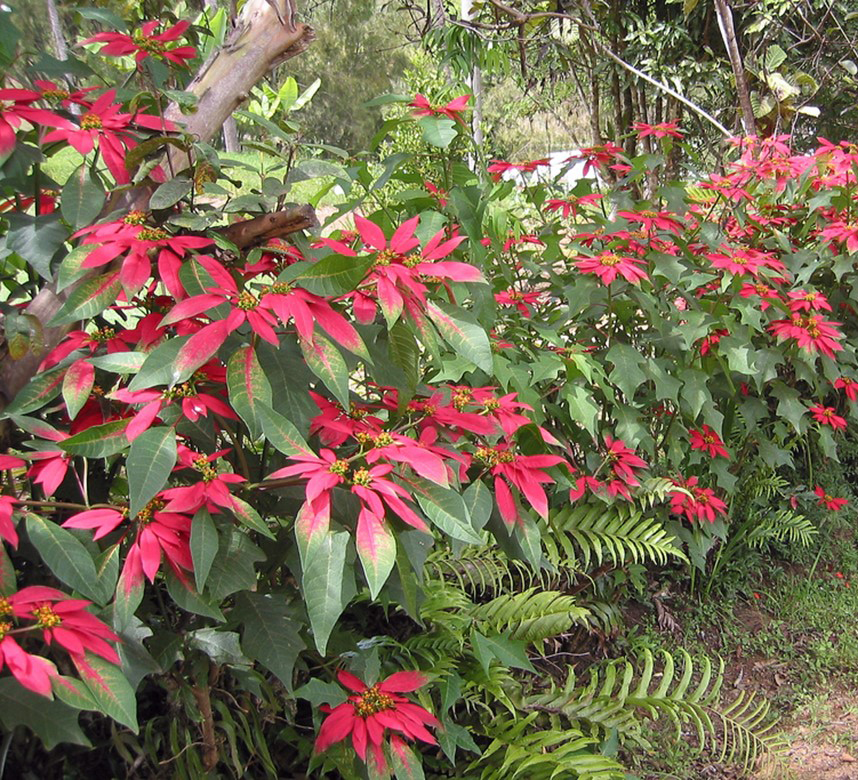Poinsettias
Like Christmas trees, Santa and reindeer, Poinsettias are famous for the brilliant color they provide indoor spaces during the colder months of the year a ubiquitous symbol of the holiday season in the U.S. and across Europe.. The name “poinsettia” is seemingly synonymous with the holiday season. 200 years after the plant with the bright crimson leaves was introduced in the U.S. The name “Poinsettia” comes from the amateur botanist and statesman Joel Roberts Poinsett, who happened upon the plant in 1828 during his tenure as the first U.S. minister to the newly independent Mexico. A life-size bronze statue of Poinsett still stands in his honor in downtown Greenville, South Carolina. The cultivation of the plant dates back to the Aztec empire in Mexico 500 years ago. It’s an apt description of the thin red leaves on wild varieties of the plant that grow to heights above 10 feet (3 meters). Year-end holiday markets in Latin America brim with the potted plant known as “flower of Christmas Eve,” which is entwined with celebrations of the night before Christmas.
Poinsettia is native to the mountains of the Pacific slope of Mexico. It is a scraggly shrub that lives in seasonally dry tropical forests. Mature the poinsettias we use to decorate our homes never reach the same sizes as their wild counterparts. The reason for this is because all cultivated poinsettias have been purposely infected with a bacteria that stunts their growth, keeping them small and compact. These shrubs flower throughout Winter and into Spring. What we think of as large, showy, red and white flower petals are not petals at all. They are actually leafy bracts. Those bracts also caught the attention of horticulturists. Because the whole function of these bracts is to save energy on flower production by coloring up leaves that are already in place. If they don’t have to produce pigments, they won’t and for much of the year, the leaves are largely green. When the days become shorter than the nights, the plants go into full reproductive mode. As soon as the days start to grow longer than the nights, the plants switch out of reproductive mode and the dazzling color fades. In greenhouses, this change is mimicked by plunging plants into complete darkness for a minimum of 12 hours per day. If you follow their natural daylight cycle, you may just coax some color out for winters to come.
Mexican poinsettias go red during the winter season. Long before European colonization, the Aztecs used the bracts to make a reddish-purple dye for fabrics and employed the sap in medicines to control fevers, skin conditions, and other ailments.” Cuetlaxochitl” was planted in gardens of the Aztec rulers and used as offerings in religious ceremonies. According to Mexican lore, a young child, Pepita set the flowers at the crèche of the nativity on Christmas Eve, the angels transformed the weeds into beautiful red flowers. This is why red and green are the colors of Christmas today. Today, Poinsettias are the most popular Christmas plant and the best-selling potted plant in the United States and Canada, contributing over $250 million to the U.S. economy at the retail level. California remains the top U.S. poinsettia-producing state. December 12 is considered National Poinsettia Day.
Flower Funnies
It’s kind of silly we’re trying turning plants into burgers
Haven’t cows been doing that for like, forever?
Here is the best one liner from the legend, Mitch Hedberg
“My fake plants died because I did not pretend to water them.”
I walked into the lobby of my apartment building recently was greeted by this notice: To whoever is watering these plans, they are property of the building, and the maintenance staff will take care of them. They may already have been watered in which case you will be overwatering them besides, these plants are fake.
Why did the plant-based chicken cross the road?
I don’t know, it’s beyond meat.
January 2nd Birthdays
1987 – Shelly Hennig, 1983 – Kate Bosworth, 1971 – Renee Elise Goldsberry, 1976 – Paz Vega
1936 – Roger Miller, 1968 – Cuba Gooding, 1971 – Taye Giggs, 1947 – Jack Hanna




